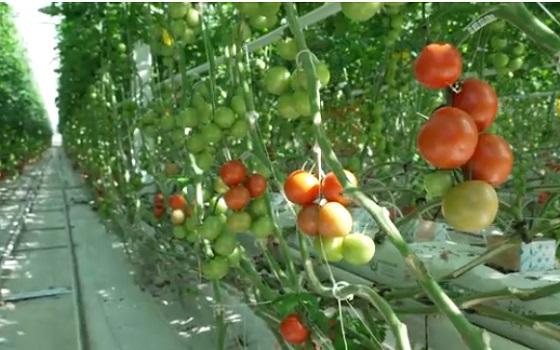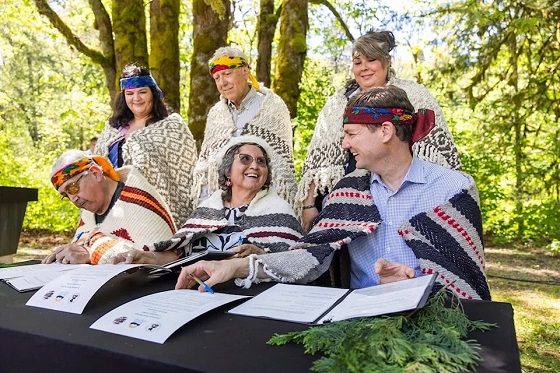Alberta
Complete overhaul of rural policing in Alberta! Province adding 500 RCMP officers and support staff

Justice Minister and Solicitor General Doug Schweitzer shakes hands with an RCMP officer in Leduc County.
Historic investment in rural policing
Alberta is adding more than 500 RCMP positions in rural communities across the province and fostering new public safety partnership with municipalities.
The Government of Alberta’s new police funding model will inject more than $286 million over five years into frontline law enforcement for these additional RCMP officer and civilian positions. This new cost-sharing partnership will see small and rural communities begin to pay a portion of frontline policing costs, bringing them into line with larger communities and cities.
Under the cost-sharing terms in the Provincial Police Service Agreement (PPSA), Alberta pays 70 per cent of policing costs and the federal government covers the remaining 30 per cent. With the additional investment from municipalities, the federal share of the PPSA will increase as well. This partnership will constitute a total increase in rural police funding of more than $286 million over five years with every dollar of the additional funds invested in frontline policing.
The province is creating a new Alberta Police Advisory Board, where municipal leadership will have a seat at the table, working in collaboration with law enforcement to ensure local needs are heard and implemented. This new governance mechanism will ensure that policing is in line with the priorities of those they are protecting.
“Ensuring Albertans are safe, secure, and protected in their communities goes to the heart of who we are as a government. We want to ensure we fund law enforcement in an equitable and sustainable way that will ensure we have more police in our communities. With this new police funding model, we are making the single largest investment in rural policing since the March West and delivering on our promise to enhance public safety.”
“Crime affects many in my own rural community, and it is an issue that is incredibly personal to me. All Albertans deserve to feel safe in their own homes and confident that they will not fall victim to violent or property crime. This new police funding model will provide increased security and certainty for rural Albertans, and value for taxpayer dollars.”
“The Government of Alberta has made an unprecedented investment in their police service, and we are ready to deliver on that commitment. The funding model announced will allow the Alberta RCMP to put additional resources where they are needed most immediately – on the frontline in your detachments, protecting your backyards and your farmyards, pushing back crime in a sophisticated and focused manner.”
“Rural Municipalities of Alberta appreciates the Government of Alberta’s willingness to consult on this issue, and as a result of input from RMA and rural municipalities, implement a phased-in police-costing model. Rural crime has been an ongoing issue in Alberta in recent years, and rural municipalities recognize they need to share in the costs of the solutions to support safer communities.”
“AUMA has long advocated for a more equitable police-funding model to address RCMP vacancies and the rising costs of policing while improving community safety. We’re pleased to see action on this critical priority by the provincial government, as safe and healthy municipalities build strong communities and a stronger Alberta. Further consultation is critical to supporting local governments with the policing resources they need, and we look forward to actively contributing to the Alberta Police Advisory Board.”
This partnership places priority on adding uniformed patrol officers in rural RCMP detachments, increasing the total number from under 1,600 to about 1,900, and will also add members to specialized RCMP units that dismantle organized crime and drug trafficking and investigate auto and scrap metal theft.
Furthermore, the new civilian positions will assist with administrative tasks and investigative support to increase response times and help ensure officers have the support network they need to protect Albertans by spending more time on roads and in communities.
Quick facts
- Small and rural communities, with some exceptions, will begin contributing a portion of their frontline policing costs in 2020. To give communities time to adjust, the new funding model is being phased in: communities will contribute 10 per cent of policing costs in 2020, followed by 15 per cent in 2021, 20 per cent in 2022 and 30 per cent in 2023.
- Policing costs for each community will be determined by municipal tax base (as measured by equalized assessment) and population to calculate a base cost. Communities will also be eligible for other subsidies that consider other factors that may affect local policing costs.
- Current annual PPSA amount, 2019-20 (prior to new police funding partnership): $374.8 million
- Government of Alberta contribution: $262.4 million
- Government of Canada contribution: $112.4 million
- Additional investments to current PPSA to April 1, 2024 will be: $286,605,021
- Government of Alberta contribution: $200,623,515
- Government of Canada contribution: $85,981,506
- All additional investments will go towards more frontline resources.
Alberta
The case for expanding Canada’s energy exports

From the Canadian Energy Centre
For Canada, the path to a stronger economy — and stronger global influence — runs through energy.
That’s the view of David Detomasi, a professor at the Smith School of Business at Queen’s University.
Detomasi, author of Profits and Power: Navigating the Politics and Geopolitics of Oil, argues that there is a moral case for developing Canada’s energy, both for Canadians and the world.
CEC: What does being an energy superpower mean to you?
DD: It means Canada is strong enough to affect the system as a whole by its choices.
There is something really valuable about Canada’s — and Alberta’s — way of producing carbon energy that goes beyond just the monetary rewards.
CEC: You talk about the moral case for developing Canada’s energy. What do you mean?
DD: I think the default assumption in public rhetoric is that the environmental movement is the only voice speaking for the moral betterment of the world. That needs to be challenged.
That public rhetoric is that the act of cultivating a powerful, effective economic engine is somehow wrong or bad, and that efforts to create wealth are somehow morally tainted.
I think that’s dead wrong. Economic growth is morally good, and we should foster it.
Economic growth generates money, and you can’t do anything you want to do in social expenditures without that engine.
Economic growth is critical to doing all the other things we want to do as Canadians, like having a publicly funded health care system or providing transfer payments to less well-off provinces.
Over the last 10 years, many people in Canada came to equate moral leadership with getting off of oil and gas as quickly as possible. I think that is a mistake, and far too narrow.
Instead, I think moral leadership means you play that game, you play it well, and you do it in our interest, in the Canadian way.
We need a solid base of economic prosperity in this country first, and then we can help others.
CEC: Why is it important to expand Canada’s energy trade?
DD: Canada is, and has always been, a trading nation, because we’ve got a lot of geography and not that many people.
If we don’t trade what we have with the outside world, we aren’t going to be able to develop economically, because we don’t have the internal size and capacity.
Historically, most of that trade has been with the United States. Geography and history mean it will always be our primary trade partner.
But the United States clearly can be an unreliable partner. Free and open trade matters more to Canada than it does to the U.S. Indeed, a big chunk of the American people is skeptical of participating in a global trading system.
As the United States perhaps withdraws from the international trading and investment system, there’s room for Canada to reinforce it in places where we can use our resource advantages to build new, stronger relationships.
One of these is Europe, which still imports a lot of gas. We can also build positive relationships with the enormous emerging markets of China and India, both of whom want and will need enormous supplies of energy for many decades.
I would like to be able to offer partners the alternative option of buying Canadian energy so that they are less reliant on, say, Iranian or Russian energy.
Canada can also maybe eventually help the two billion people in the world currently without energy access.
CEC: What benefits could Canadians gain by becoming an energy superpower?
DD: The first and primary responsibility of our federal government is to look after Canada. At the end of the day, the goal is to improve Canada’s welfare and enhance its sovereignty.
More carbon energy development helps Canada. We have massive debt, an investment crisis and productivity problems that we’ve been talking about forever. Economic and job growth are weak.
Solving these will require profitable and productive industries. We don’t have so many economic strengths in this country that we can voluntarily ignore or constrain one of our biggest industries.
The economic benefits pay for things that make you stronger as a country.
They make you more resilient on the social welfare front and make increasing defence expenditures, which we sorely need, more affordable. It allows us to manage the debt that we’re running up, and supports deals for Canada’s Indigenous peoples.
CEC: Are there specific projects that you advocate for to make Canada an energy superpower?
DD: Canada’s energy needs egress, and getting it out to places other than the United States. That means more transport and port facilities to Canada’s coasts.
We also need domestic energy transport networks. People don’t know this, but a big chunk of Ontario’s oil supply runs through Michigan, posing a latent security risk to Ontario’s energy security.
We need to change the perception that pipelines are evil. There’s a spiderweb of them across the globe, and more are being built.
Building pipelines here, with Canadian technology and know-how, builds our competitiveness and enhances our sovereignty.
Economic growth enhances sovereignty and provides the resources to do other things. We should applaud and encourage it, and the carbon energy sector can lead the way.
Agriculture
Growing Alberta’s fresh food future

A new program funded by the Sustainable Canadian Agricultural Partnership will accelerate expansion in Alberta greenhouses and vertical farms.
Albertans want to keep their hard-earned money in the province and support producers by choosing locally grown, high-quality produce. The new three-year, $10-milllion Growing Greenhouses program aims to stimulate industry growth and provide fresh fruit and vegetables to Albertans throughout the year.
“Everything our ministry does is about ensuring Albertans have secure access to safe, high-quality food. We are continually working to build resilience and sustainability into our food production systems, increase opportunities for producers and processors, create jobs and feed Albertans. This new program will fund technologies that increase food production and improve energy efficiency.”
“Through this investment, we’re supporting Alberta’s growers and ensuring Canadians have access to fresh, locally-grown fruits and vegetables on grocery shelves year-round. This program strengthens local communities, drives innovation, and creates new opportunities for agricultural entrepreneurs, reinforcing Canada’s food system and economy.”
The Growing Greenhouses program supports the controlled environment agriculture sector with new construction or expansion improvements to existing greenhouses and vertical farms that produce food at a commercial scale. It also aligns with Alberta’s Buy Local initiative launched this year as consumers will be able to purchase more local produce all year-round.
The program was created in alignment with the needs identified by the greenhouse sector, with a goal to reduce seasonal import reliance entering fall, which increases fruit and vegetable prices.
“This program is a game-changer for Alberta’s greenhouse sector. By investing in expansion and innovation, we can grow more fresh produce year-round, reduce reliance on imports, and strengthen food security for Albertans. Our growers are ready to meet the demand with sustainable, locally grown vegetables and fruits, and this support ensures we can do so while creating new jobs and opportunities in communities across the province. We are very grateful to the Governments of Canada and Alberta for this investment in our sector and for working collaboratively with us.”
Sustainable Canadian Agricultural Partnership (Sustainable CAP)
Sustainable CAP is a five-year, $3.5-billion investment by federal, provincial and territorial governments to strengthen competitiveness, innovation and resiliency in Canada’s agriculture, agri-food and agri-based products sector. This includes $1 billion in federal programs and activities and $2.5 billion that is cost-shared 60 per cent federally and 40 per cent provincially/territorially for programs that are designed and delivered by provinces and territories.
Quick facts
- Alberta’s greenhouse sector ranks fourth in Canada:
- 195 greenhouses produce $145 million in produce and 60 per cent of them operate year-round.
- Greenhouse food production is growing by 6.2 per cent annually.
- Alberta imports $349 million in fresh produce annually.
- The program supports sector growth by investing in renewable and efficient energy systems, advanced lighting systems, energy-saving construction, and automation and robotics systems.
Related information
-

 Focal Points2 days ago
Focal Points2 days agoCommon Vaccines Linked to 38-50% Increased Risk of Dementia and Alzheimer’s
-

 Automotive1 day ago
Automotive1 day agoThe $50 Billion Question: EVs Never Delivered What Ottawa Promised
-

 Alberta17 hours ago
Alberta17 hours agoAlberta introducing three “all-season resort areas” to provide more summer activities in Alberta’s mountain parks
-

 Health2 days ago
Health2 days agoThe Data That Doesn’t Exist
-

 Business1 day ago
Business1 day agoStorm clouds of uncertainty as BC courts deal another blow to industry and investment
-

 Agriculture16 hours ago
Agriculture16 hours agoGrowing Alberta’s fresh food future
-

 Business2 days ago
Business2 days agoThe Climate-Risk Industrial Complex and the Manufactured Insurance Crisis
-

 International15 hours ago
International15 hours agoTrump admin wants to help Canadian woman rethink euthanasia, Glenn Beck says






